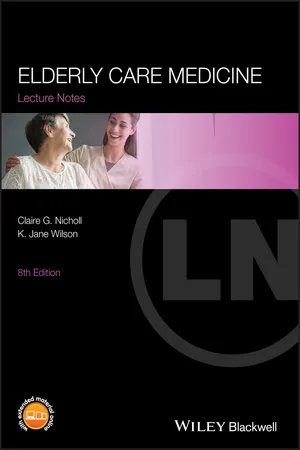
- English
- ePUB (mobile friendly)
- Available on iOS & Android
Elderly Care Medicine
About this book
Presented in a user-friendly format, combining readability with high-quality illustrations, this eighth edition has been thoroughly revised to reflect advances in knowledge on how disease presents in elderly people, and changes in management practice, particularly regarding stroke, dementia, delirium, and cancer.
New for this edition, Elderly Care Medicine Lecture Notes also features:
- More treatment tables and boxes throughout for rapid access and revision
- Expansion of material on polypharmacy and prescribing
- Discussion of emotional support, counselling and spirituality
- Advice for doctors on breaking bad news and end-of-life care
- Consideration of ethical and legal issues
A companion website at www.lecturenoteseries.com/elderlycaremed features appendices which can be used as guidelines in a clinical setting, key revision points for each chapter, further reading suggestions, and extended content for specialty training in geriatrics.
Not only is this book a great starting point to support initial teaching on the topic, but it is also easy to dip in and out of for reference or revision at the end of a module, rotation or final exams. Whether you need to develop or refresh your knowledge of geriatrics, Elderly Care Medicine Lecture Notes presents 'need to know' information for all those involved in treating elderly people.
Frequently asked questions
- Essential is ideal for learners and professionals who enjoy exploring a wide range of subjects. Access the Essential Library with 800,000+ trusted titles and best-sellers across business, personal growth, and the humanities. Includes unlimited reading time and Standard Read Aloud voice.
- Complete: Perfect for advanced learners and researchers needing full, unrestricted access. Unlock 1.4M+ books across hundreds of subjects, including academic and specialized titles. The Complete Plan also includes advanced features like Premium Read Aloud and Research Assistant.
Please note we cannot support devices running on iOS 13 and Android 7 or earlier. Learn more about using the app.
Information
Introduction
| Article 2 | Right to life. |
| Article 3 | Prohibition of torture and inhuman and degrading treatment. |
| Article 8 | Right to respect for private and family life and home. |
| Article 10 | Freedom of expression and right to information. |
| Article 14 | Right not to be discriminated against. |
Population Trends
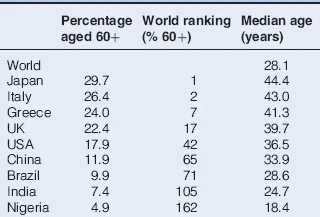
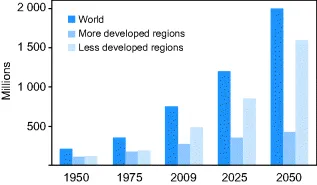
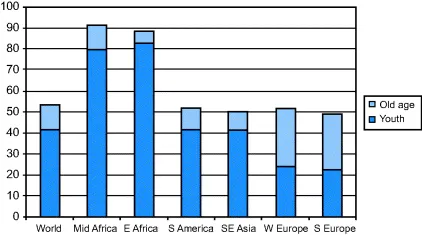
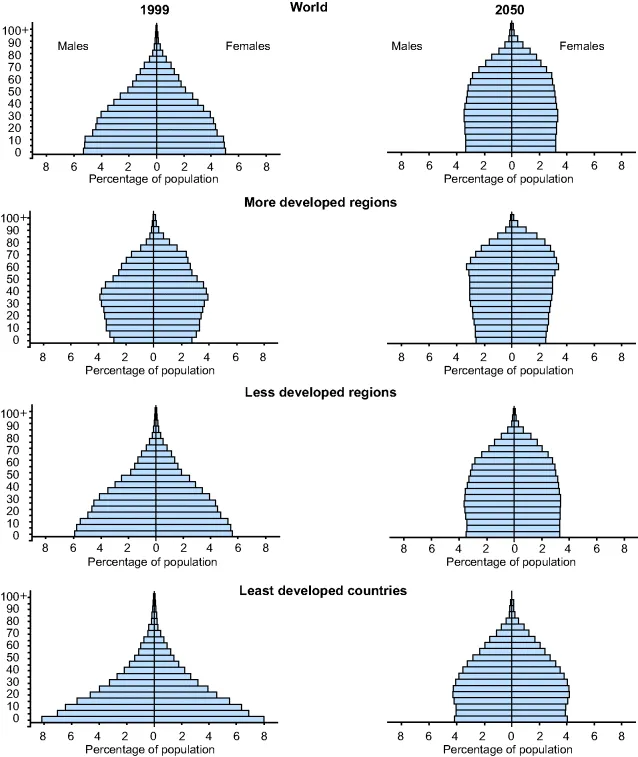
Developed Countries
Demographic Changes
- Death which was common in infancy and usual before 65 years is now rare in infancy and unusual before 65 years.
- Life expectancy continues to rise, partly due to improvements in medical care of conditions such as hypertension and ischaemic heart disease.
- The dramatic rise in the elderly population over the past 100 years is now slowing.
- However, the number of ‘old old’, i.e. those ≥ 80 years of age, is still increasing rapidly.
- The Commission on Global Ageing warns of the risk of ‘ageing recessions’ due to a fall in the size of the workforce (labour shortages) plus increased service demands (caring services). In 2010, China overtook Japan as the world's second largest economy, due in part to the ageing and shrinking population of Japan.
Medical Services
- Sophisticated health systems are established with specialist services for the elderly.
- Population trends alone require increased health funding each year (estimated at 1% per year in the UK) in addition to inflation and costs due to technological development.
- Rising expectations of older people and their carers fuel rising health costs.
- Ethical dilemmas will be more pressing, e.g. the prolongation of death by technological intervention or medicated survival of the young chronically sick and acutely ill, and frail, elderly patients.
- Financial provision must be made to support the choices made. An elderly person costs the health services nine times as much as a young person.
- Medical training continues to concentrate on increasing specialization, so practitioners cannot cope with complex aetiologies (sociological, psychological and medical) and multi-pathology (co-morbidity), and the atypical presentations common in elderly patients, i.e. a mismatch between aspirations of young medics and the needs of their elderly patients.
Community Services
- Community care is individually based and very varied. Comparison between provision in different countries is difficult because of political, socio-economic and demographic differences. It is easier to make comparisons with regard to institutional care, usually in residential or nursing homes. There used to be marked variation between countries, but figures are converging to 5–9% of the 65+ group being in care (5.5% in 2006 in England).
- The historical development of the patterns of care is similar. In all societies there has always been a heavy reliance on self-sufficiency and family care. The healthy and wealthy old have always faired the best. For the more disadvantaged, there has always been a need to rely on support from non-family members.
- In the ‘Old World’, non-family support was originally provided by the church or by occupationally related charities or guilds. In England, the state began to become more prominent in the 17th century with the first Poor Law Act, which provided workhouse care an...
Table of contents
- Cover
- Title Page
- Copyright
- Preface
- Abbreviations
- Chapter 1: The World Grows Old
- Chapter 2: Health and Social Care for Elderly People in the UK
- Chapter 3: Special Features of Medicine in the Elderly
- Chapter 4: Old Age Psychiatry
- Chapter 5: Falls and Immobility
- Chapter 6: Bones, Joints and Muscles
- Chapter 7: Stroke Made Simple
- Chapter 8: Other Diseases of the Nervous System
- Chapter 9: Cardiovascular Disorders
- Chapter 10: Respiratory Disease
- Chapter 11: Gastrointestinal Disease and Nutrition
- Chapter 12: Disorders of Homeostasis and Metabolism
- Chapter 13: Genitourinary Disease
- Chapter 14: Blood and Bone Marrow
- Chapter 15: Eyes, Ears, Mouth and Skin
- Chapter 16: Legal and Ethical Aspects of Medical Care of Elderly People
- Chapter 17: Palliative Care
- Index